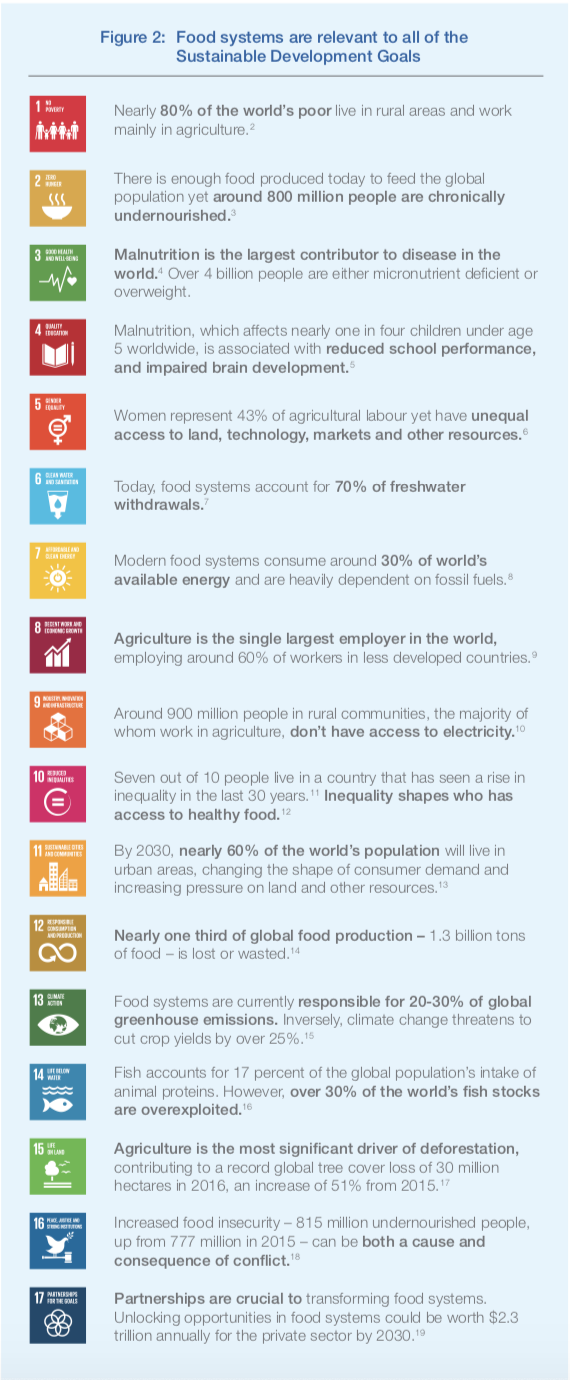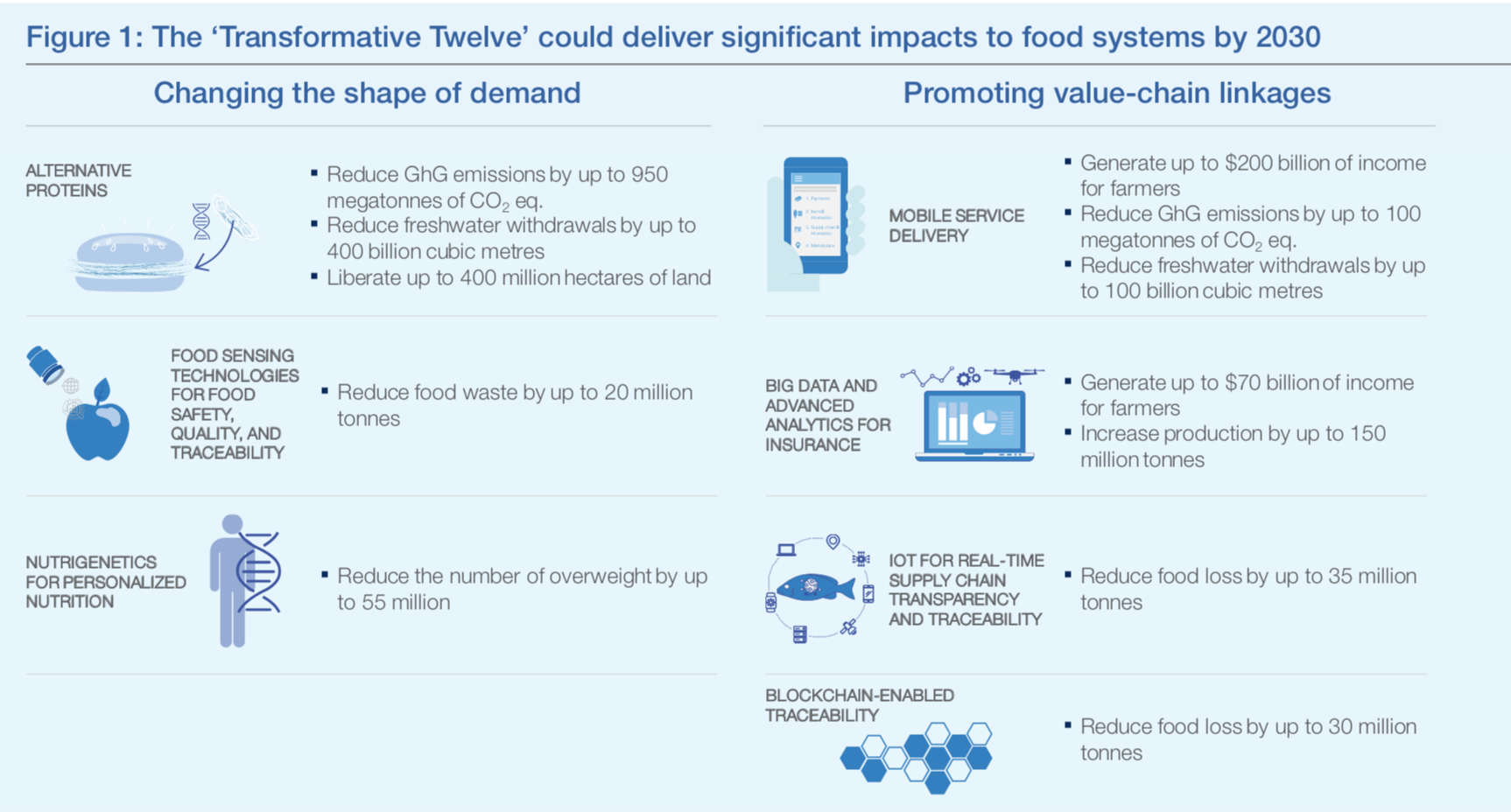Global food systems today are unsustainable for both people and the planet. They leave billions of people inadequately nourished, operate at a high environmental cost, waste large amounts of what is produced and leave many of their producers at or below the poverty level.
As such, stakeholders from all sectors and regions have recognized the need for a fundamental transformation of food systems – a transformation that will address the significant challenges across food systems and advance all of the Sustainable Development Goals (SDGs).

Such a transformation would create not only social value, but economic value as well. New business opportunities generated in the course of addressing Sustainable Development Goals in the food and agriculture sector could reach $2.3 trillion annually by 2030, according to the Business and Sustainable Development Commission.
A Vision For Transformation
To feed almost 10 billion people by 205021, while meeting the Sustainable Development Goals (SDGs), food systems will need to be:
– Inclusive – ensuring economic and social inclusion for all food systems actors, including smallholder farms, women and youth
– Sustainable – minimizing negative environmental impacts, conserving scarce natural resources, saving biodiversity loss and strengthening resiliency against future shocks
– Efficient – producing adequate quantities of nutritious and healthy foods for global needs while minimizing loss and waste
– Nutritious and healthy – providing and promoting the consumption of diverse nutritious and safe foods for a healthy diet.
Achieving this vision requires considering the environmental, economic, and health-related dimensions of food systems. It requires continued investments in crop improvement technologies, management practices, policy and governance, business model innovation and other strategies that have been proven over the last decade. And it requires substantial innovation and departures from the status quo.
Food Systems Are Ripe For Technology Disruption
Global food systems today are riddled with inefficiency and ineffectiveness. Consider a few examples:
– Approximately 500 million smallholder farmers produce 80% of the food consumed in the developing world. However, farming as an occupation is on the decline. Developing viable and attractive jobs for growing numbers of young people will be crucial to both economic and political stability.
– Food systems are currently responsible for 20 – 30% of global greenhouse gas emissions, 70% of freshwater withdrawals and 70% of biodiversity loss. Twice as much water will be required for food production in 2050 but nearly one-third of agricultural production today takes place in water-stressed regions. Dramatically reducing the environmental footprint of food production is essential for sustainably meeting the needs of a growing population.
– Nearly one-third of global food production – 1.3 billion tonnes of food – is lost along the supply chain or wasted by consumers and retailers. Reducing this waste could cut costs, improve incomes and alleviate negative impacts on the environment.
– Nearly 800 million people are chronically undernourished and 2 billion are micronutrient deficient. Approximately 155 million children under the age of five suffer from stunted growth25, while 2 billion people are overweight or obese. Improving access to affordable nutritious food is essential for reducing poor nutrition and the associated health costs.
There are significant barriers to addressing these challenges. Constraints in changing consumer behaviour, together with the limited innovation in food product development and distribution and a lack of proper incentives and access, limit our ability to shift consumer demand towards more nutritious and sustainable diets. Inadequate infrastructure, information, and financial inclusion make it difficult for farmers to gain access to cost-effective products, services, and information that could boost their productivity and profitability. The lack of transparency along supply chains has resulted in a loss of consumer trust. The high cost of developing crop technologies has reduced crop diversity, generating both dietary and environmental consequences. On a systemic level, the lack of a holistic approach across relevant sectors (including agriculture, health, and environment) prevents both policymakers and investors from making the right decisions to improve food systems.

Although these barriers are considerable, Fourth Industrial Revolution (4IR) technologies are making it easier to dismantle some of them. Taken together, these innovative technologies lower cost to scale, accelerate innovation, increase transparency in food systems, enable consumers to make informed choices, and allow policy makers to engage in evidence-based policy making.
Fourth Industrial Revolution technologies
Technologies are transforming the world around us. Improvements in the performance and cost of computing power, storage and bandwidth have led to the growth of digital technologies. Together, with advances in science and technologies that are altering the physical world, Fourth Industrial Revolution technologies are driving significant innovations. A wide array of industries – telecommunications media, transportation, life sciences and more – are experiencing the disruptive effects of emerging technologies.
These technologies are also transforming how innovations are being conceptualized, designed and commercialized and, more generally, how businesses operate. For example, companies such as Kickstarter, Innocentive, Crowd Spring, Amazon, Google, and Salesforce have created online platforms that reduce the barriers to entry and transaction costs for innovators developing and commercialising new products of their own.

